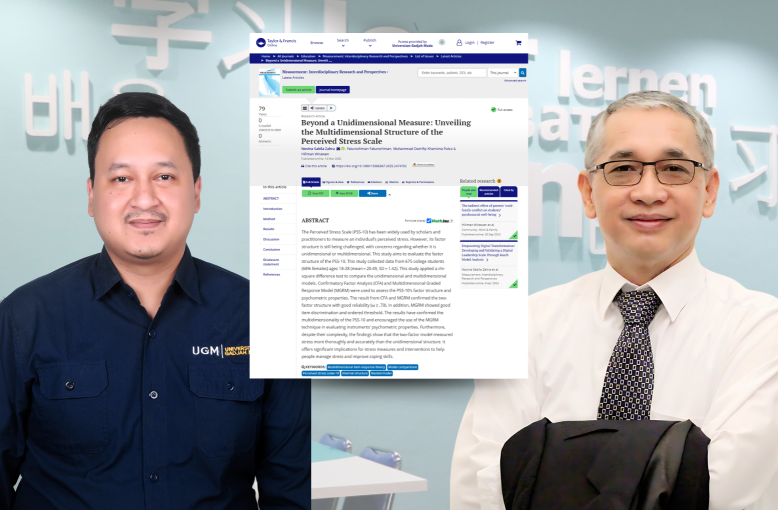
Yogyakarta, 27 Maret 2025 – Artikel penelitian berjudul “Beyond a Unidimensional Measure: Unveiling the Multidimensional Structure of the Perceived Stress Scale” yang ditulis Zahra, N. S., Faturochman, Putra, M. D. K., & Wirawan, H., telah terbit pada Jurnal Measurement: Interdisciplinary Research and Perspectives secara online pada 14 Maret 2025, (Scopus Q3, SJR 2023: 0,327, dan IF 2023: 0,6).
Penelitian ini menyoroti pentingnya pendekatan multidimensional dalam mengukur tingkat stres. Penelitian ini mengkaji ulang Perceived Stress Scale (PSS) yang selama ini dianggap sebagai alat ukur unidimensional. Dengan metode analisis terbaru, para peneliti menemukan bahwa stres memiliki struktur yang lebih kompleks dari yang diperkirakan sebelumnya. Hasil penelitian ini dapat berimplikasi besar dalam bidang psikologi dan kesehatan mental, terutama dalam perancangan intervensi yang lebih tepat sasaran. Studi ini menekankan perlunya pengukuran yang lebih akurat untuk memahami pengalaman stres individu secara lebih mendalam.
Abstract. The Perceived Stress Scale (PSS-10) has been widely used by scholars and practitioners to measure an individual’s perceived stress. However, its factor structure is still being challenged, with concerns regarding whether it is unidimensional or multidimensional. This study aims to evaluate the factor structure of the PSS-10. This study collected data from 675 college students (68% females) ages 18-28 (mean = 20.49, SD = 1.42). This study applied a chi-square difference test to compare the unidimensional and multidimensional models. Confirmatory Factor Analysis (CFA) and Multidimensional Graded Response Model (MGRM) were used to assess the PSS-10’s factor structure and psychometric properties. The result from CFA and MGRM confirmed the two-factor structure with good reliability (ω ≥ .70). In addition, MGRM showed good item discrimination and ordered threshold. The results have confirmed the multidimensionality of the PSS-10 and encouraged the use of the MGRM technique in evaluating instruments’ psychometric properties. Furthermore, despite their complexity, the findings show that the two-factor model measured stress more thoroughly and accurately than the unidimensional structure. It offers significant implications for stress measures and interventions to help people manage stress and improve coping skills.
Keywords: Multidimensional itemresponse theory; Modelcomparisons; Perceivedstress scale-10; Internalstructure; Nested model
Publikasi ini dapat diakses di Link:
https://www.tandfonline.com/doi/full/10.1080/15366367.2025.2474702?src=exp-la
Berdasarkan kata kuncinya, artikel ini adalah luaran penelitian yang fokus pada SDG: 3 dan 4
Selamat kepada pak Fatur, mas Rifqi dan tim penulis.
***
Penulis & Editor: Tim UP & Humas
